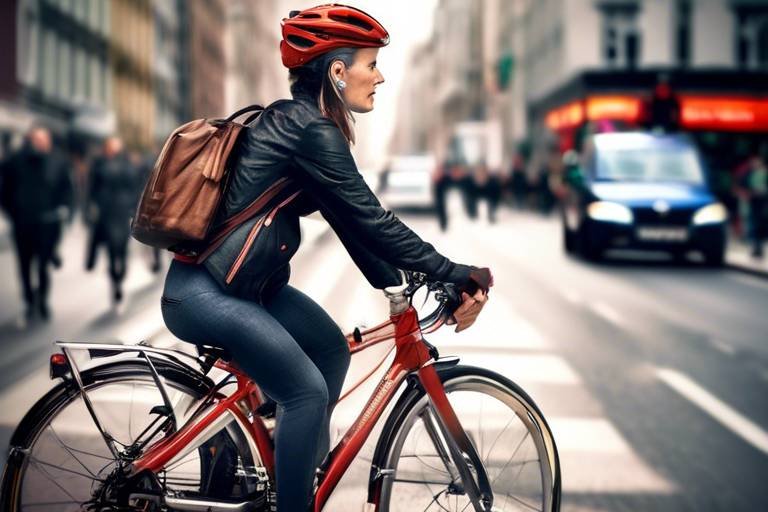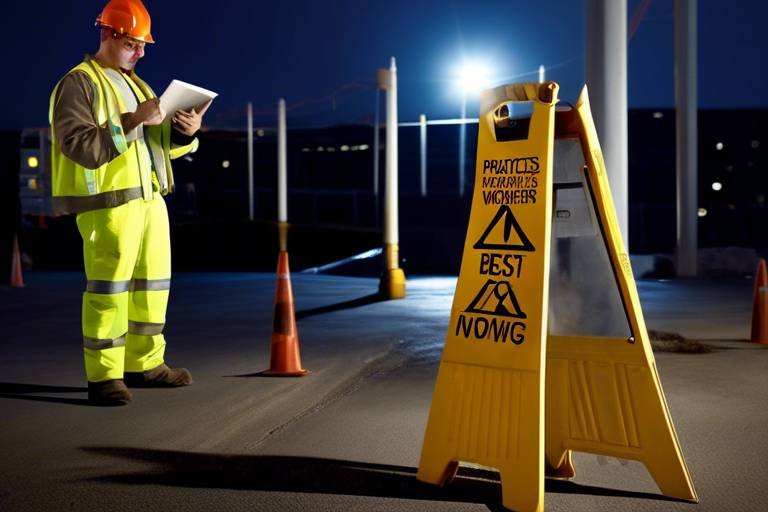Common misconceptions about personal safety
When it comes to personal safety, many of us hold some misconceptions that can lead to risky behaviors and a false sense of security. Understanding these myths is crucial for enhancing our awareness and preparedness. Personal safety is not just about physical defense; it encompasses a broad spectrum of strategies and mindsets that can significantly impact our well-being in various situations. With the right knowledge, we can navigate our environments more safely and confidently.
One major misconception is that personal safety is solely about physical self-defense techniques. While knowing how to defend oneself can be beneficial, it is just a small piece of the puzzle. Personal safety also involves being aware of your surroundings, understanding potential threats, and knowing how to prevent dangerous situations before they arise. Think of it like a chess game; it's not just about the moves you make but also about anticipating your opponent's actions and planning several steps ahead.
Another prevalent myth is that crime only occurs in dangerous neighborhoods. This belief can lead to a dangerous sense of complacency, as crime can happen in any area, including those that seem perfectly safe. It's essential to remain vigilant and practice safety measures no matter where you are. By analyzing crime statistics, we can gain insights into where and how crimes occur, debunking the myth that only certain areas are unsafe. For example, a neighborhood may have a low crime rate on paper, but that doesn't mean you should let your guard down.
Analyzing crime statistics can provide valuable insights that help debunk the myth that only certain areas are unsafe. These statistics reveal that crime can happen anywhere, which emphasizes the need for constant awareness and preventive measures. For example, consider the following table that showcases crime rates in various environments:
| Location | Crime Rate (per 1,000 residents) |
|---|---|
| Urban Area | 7.5 |
| Suburban Area | 3.2 |
| Rural Area | 1.1 |
As you can see, even areas that are perceived as safe can have crime rates that warrant caution. Understanding these dynamics helps individuals recognize that safety is a universal concern, not limited by geography.
Socioeconomic conditions can influence crime rates, but they do not define personal safety. For instance, a wealthy neighborhood can still experience crime, just as a less affluent area can be exceptionally safe. Recognizing this reality helps us appreciate the complexities of safety and encourages us to remain vigilant, regardless of our surroundings.
Familiarizing oneself with prevalent crime types in various locations can better prepare individuals. This knowledge encourages proactive measures and awareness, regardless of the perceived safety of an area. Common crime types include:
- Theft
- Burglary
- Assault
- Fraud
By being aware of these risks, you can take appropriate steps to mitigate them, such as securing your home or being cautious when sharing personal information online.
Many people feel safe in familiar environments, leading to complacency. However, understanding that even known spaces can harbor risks is crucial for maintaining vigilance and implementing safety practices. Just because you know your neighborhood well doesn’t mean you should let your guard down. Always be aware of your surroundings, even in places you visit regularly.
While personal safety devices like pepper spray or alarms can aid in emergencies, relying solely on them can create a false sense of security. Awareness and preparedness are vital components of personal safety. Think of these devices as tools in your toolbox; they can be useful, but they won't fix every problem. It's essential to understand their limitations and not let them replace your situational awareness.
Safety devices often have limitations, such as accessibility or effectiveness in certain situations. For example, if your pepper spray is buried at the bottom of your bag when you need it most, it won't do you any good. Understanding these limitations can help individuals develop a comprehensive safety plan beyond just carrying a device. Always have a backup plan and be prepared to think on your feet.
Selecting appropriate personal safety devices involves considering personal needs and situations. Researching and understanding how to use these devices effectively is essential for maximizing their potential benefits. Remember, a device is only as good as the person using it. Take the time to learn how to operate your safety tools and practice using them in safe environments.
Q: What is the most effective way to ensure personal safety?
A: The most effective way to ensure personal safety is a combination of awareness, preparation, and using appropriate safety tools. Always stay alert, trust your instincts, and have a plan in place.
Q: Are personal safety devices worth the investment?
A: Yes, personal safety devices can be beneficial, but they should not be your only line of defense. They are most effective when combined with situational awareness and preventive strategies.
Q: How can I improve my situational awareness?
A: You can improve your situational awareness by practicing mindfulness, paying attention to your surroundings, and regularly updating yourself on local crime trends.

Myth 1: Personal Safety is Only About Physical Defense
This article addresses prevalent myths surrounding personal safety, providing insights and clarifications that can help individuals better understand how to protect themselves effectively in various situations.
When we think about personal safety, many of us immediately picture physical self-defense techniques, like martial arts or carrying pepper spray. However, this narrow view misses the bigger picture. Personal safety encompasses much more than just being able to throw a punch or wield a weapon. It's about awareness, prevention strategies, and mental preparedness. Imagine walking down a street, confident in your ability to defend yourself, but completely oblivious to the potential dangers lurking around you. That’s where the misconception lies.
Awareness is your first line of defense. It’s not just about knowing how to react in a threatening situation, but also about recognizing potential threats before they escalate. For instance, being aware of your surroundings can help you identify suspicious behavior or avoid potentially dangerous situations altogether. Think of it like driving; you don’t just focus on the road directly in front of you but also keep an eye on your mirrors and surroundings to anticipate any hazards.
Moreover, prevention strategies play a crucial role in personal safety. This includes things like planning your route before heading out, staying in well-lit areas, and even informing someone of your whereabouts. It’s akin to preparing for a trip; you wouldn’t just throw your bags in the car and hope for the best, right? You’d check the weather, plan your stops, and ensure your vehicle is roadworthy. Similarly, planning for your safety can significantly reduce risks.
Mental preparedness is another vital aspect that is often overlooked. This involves having the right mindset to respond effectively in a crisis. It’s about training your brain to stay calm and think clearly when faced with danger. Just like athletes visualize their performance before a big game, you can practice mental rehearsals for various scenarios. This preparation can make a world of difference when it counts.
In summary, while physical defense is undoubtedly a part of personal safety, it is just one piece of a much larger puzzle. By focusing solely on physical techniques, we risk neglecting the essential elements of awareness, prevention, and mental readiness. So next time you think about personal safety, remember that it’s a multifaceted concept that requires a holistic approach.
- What are some effective awareness techniques? Staying alert, making eye contact with those around you, and avoiding distractions like your phone can enhance your awareness.
- How can I improve my mental preparedness? Engage in scenario-based training or visualization exercises to help prepare your mind for potential threats.
- Are there specific prevention strategies I should follow? Yes, always plan your routes, stay in well-lit areas, and inform someone of your plans when going out.

Myth 2: Crime Happens Only in Dangerous Areas
Many people operate under the misconception that crime is confined to neighborhoods that are labeled as "dangerous." This belief can lead to a false sense of security in seemingly safe areas, where individuals may let their guard down. The reality is that crime can happen anywhere, regardless of the perceived safety of a location. It’s crucial to understand that criminals do not adhere to boundaries; they will strike wherever opportunities arise.
To truly grasp the scope of this issue, it’s important to consider crime statistics. Analyzing these numbers reveals patterns that contradict the notion of safety being tied solely to geography. For instance, an area that appears peaceful may have a hidden spike in certain types of crime, such as theft or vandalism. This is why awareness and vigilance are necessary, even in familiar environments.
Crime statistics can serve as a valuable tool in debunking the myth that only certain areas are unsafe. By examining data from local law enforcement agencies or national crime reports, individuals can gain insights into where and how crimes are occurring. For example, a suburban neighborhood might experience a rise in property crimes during summer months when families are on vacation. Recognizing these trends can empower individuals to adopt proactive safety measures.
While it’s true that socioeconomic conditions can influence crime rates, they do not solely define personal safety. Areas with lower income levels might experience higher crime rates, but affluent neighborhoods are not immune to criminal activity. In fact, the perception of safety can sometimes lead to complacency among residents, making them prime targets. Understanding the dynamics of crime helps individuals recognize that safety is a universal concern, transcending geographical and economic boundaries.
Familiarizing oneself with prevalent crime types in various locations can better prepare individuals for potential risks. Here are some common crime types to be aware of:
- Theft: Often occurs in both urban and suburban areas, targeting homes, vehicles, and personal belongings.
- Assault: Can happen anywhere, including seemingly safe neighborhoods, often stemming from personal disputes.
- Fraud: Increasingly common in the digital age, affecting individuals regardless of their location.
Understanding these crime types encourages proactive measures and awareness, regardless of the perceived safety of an area. It’s not enough to simply assume that because you live in a "nice" neighborhood, you are safe. Instead, staying informed and alert is essential.
Another aspect to consider is the tendency for individuals to feel safe in familiar environments, leading to a dangerous level of complacency. Just because you know your neighborhood well doesn’t mean it’s free from risks. For instance, many people may leave their doors unlocked or fail to be aware of their surroundings while walking in their own neighborhoods. This can create opportunities for criminals who are always on the lookout for easy targets.
In conclusion, the myth that crime only happens in dangerous areas is not only misleading but also potentially dangerous. By educating ourselves about crime statistics, understanding the impact of socioeconomic factors, and familiarizing ourselves with common crime types, we can create a more comprehensive approach to personal safety. Remember, safety is not just about avoiding certain areas; it’s about being aware and prepared no matter where you are.
Q: What should I do if I feel unsafe in my neighborhood?
A: Trust your instincts. If you feel unsafe, consider reaching out to local law enforcement or community watch programs. Engaging with your neighbors can also create a stronger sense of community and safety.
Q: How can I stay informed about crime in my area?
A: Utilize local news outlets, online crime maps, and community forums to stay updated on crime trends. Many police departments also provide crime reports on their websites.
Q: Are personal safety devices effective in preventing crime?
A: While personal safety devices can provide an added layer of security, they should not be relied upon solely. Awareness and preventive measures are equally important in ensuring personal safety.

Understanding Crime Statistics
This article addresses prevalent myths surrounding personal safety, providing insights and clarifications that can help individuals better understand how to protect themselves effectively in various situations.
Many believe that personal safety solely depends on physical self-defense techniques. This misconception overlooks the importance of awareness, prevention strategies, and mental preparedness in ensuring one’s safety in everyday situations.
A common fallacy is that crime is restricted to high-crime neighborhoods. In reality, crime can occur anywhere, making it essential for individuals to remain vigilant and practice safety measures regardless of their surroundings.
Understanding crime statistics is crucial for debunking the notion that danger lurks only in specific areas. When we dive into the numbers, we often find that crime is a widespread issue, transcending social and geographical boundaries. For instance, urban environments may have higher reported crime rates, but that doesn't mean rural areas are immune. In fact, many crimes go unreported, skewing our perception of safety.
To truly grasp the scope of crime, it's essential to consider various factors, including the types of crime prevalent in different locations. For example, property crimes like burglary might be more common in suburban areas, while violent crimes could occur more frequently in urban settings. Here’s a brief overview of common crime types:
| Type of Crime | Common Locations |
|---|---|
| Burglary | Suburban neighborhoods |
| Assault | Urban centers |
| Robbery | Commercial areas |
| Vandalism | Schools and parks |
Moreover, understanding crime statistics helps individuals develop a proactive approach to safety. By analyzing trends, one can identify peak times for certain crimes, which can inform when to be more alert. For example, if statistics show that thefts rise during the holiday season, individuals can take extra precautions during that time.
Another vital aspect is recognizing the impact of socioeconomic factors on crime rates. While it’s easy to assume that poverty-stricken areas are the most dangerous, many affluent neighborhoods also experience crime. This is often due to factors such as:
- Increased opportunity for theft due to valuable possessions.
- Higher population density, which can lead to more interactions and potential conflicts.
- Isolation and lack of community engagement, making it easier for crime to occur unnoticed.
By understanding these dynamics, individuals can see that safety is a universal concern, not limited by geography. It's essential to remain vigilant, even in familiar environments where one might feel safest.
While personal safety devices like pepper spray or alarms can aid in emergencies, relying solely on them can create a false sense of security. Awareness and preparedness are vital components of personal safety.
Safety devices often have limitations, such as accessibility or effectiveness in certain situations. Understanding these limitations can help individuals develop a comprehensive safety plan beyond just carrying a device.
Selecting appropriate personal safety devices involves considering personal needs and situations. Researching and understanding how to use these devices effectively is essential for maximizing their potential benefits.
- What is the best way to stay safe in unfamiliar areas? Always stay aware of your surroundings, trust your instincts, and avoid distractions like excessive phone usage.
- Are personal safety apps effective? Yes, many apps can enhance your safety by allowing you to quickly share your location or alert authorities.
- How can I educate myself about local crime statistics? Many local police departments publish crime reports online, and community forums can also provide insights.

Impact of Socioeconomic Factors
The relationship between socioeconomic factors and personal safety is a complex one. Many people mistakenly believe that crime is solely a product of individual choices, ignoring the broader societal influences at play. For instance, areas with high poverty rates often experience elevated crime levels, but this doesn't mean that safety is only a concern in those neighborhoods. In fact, socioeconomic conditions can create environments where crime flourishes, affecting everyone, regardless of their immediate surroundings. It's essential to understand that personal safety is not just about avoiding certain locations; it's about recognizing the underlying issues that contribute to crime.
Consider the following aspects of socioeconomic factors and their impact on personal safety:
- Education: Areas with lower educational attainment often correlate with higher crime rates. Education equips individuals with skills and knowledge that can lead to better job opportunities, reducing the likelihood of engaging in criminal activity.
- Employment Opportunities: Economic instability can drive individuals toward crime as a means of survival. A lack of job prospects can foster desperation, leading to an increase in theft, robbery, and other offenses.
- Community Resources: Communities with access to resources such as mental health services, recreational programs, and social support tend to have lower crime rates. These resources can help individuals cope with stressors that might otherwise lead to criminal behavior.
It’s important to note that while these factors can influence crime rates, they do not define personal safety for everyone. A wealthy neighborhood can still experience crime, and individuals from lower socioeconomic backgrounds can live safely. Understanding this dynamic allows individuals to approach personal safety with a more informed perspective, recognizing that vigilance and preparedness are necessary no matter where one resides.
Moreover, being aware of the socioeconomic context of a community can help individuals identify potential risks and adopt proactive measures. For example, knowing that a neighborhood has limited resources might encourage residents to form community watch groups or engage in local safety initiatives. This collective awareness can significantly enhance personal safety and create a supportive environment where everyone looks out for one another.
Q: How can I stay safe in my neighborhood?
A: Staying safe involves being aware of your surroundings, engaging with your community, and having a safety plan in place. Regularly review local crime statistics and participate in community safety programs.
Q: Are personal safety devices effective?
A: While personal safety devices can be helpful, they should not be your only line of defense. It's essential to combine their use with awareness and preparedness for various situations.
Q: Can socioeconomic factors affect my personal safety even in affluent areas?
A: Yes, crime can occur anywhere, including affluent areas. Understanding the broader socioeconomic dynamics can help you remain vigilant regardless of your environment.

Common Crime Types
Understanding the landscape of crime is crucial for personal safety. By familiarizing ourselves with , we can better prepare and protect ourselves in various situations. Crime is not a one-size-fits-all category; it manifests in different forms, each with its own implications and prevention strategies. Some of the most prevalent types of crime include:
- Theft: This encompasses a range of activities from shoplifting to burglary. It's essential to be aware of your surroundings, especially in crowded areas or when leaving your home unattended.
- Assault: This can vary from verbal threats to physical attacks. Knowing how to identify potential threats and de-escalate situations can be a lifesaver.
- Fraud: With the rise of online transactions, fraud has become increasingly common. It's vital to protect personal information and be cautious about sharing sensitive data.
- Vandalism: Often seen as a nuisance, vandalism can escalate and lead to more severe crimes. Being part of a community that actively discourages such behavior can foster a safer environment.
- Cybercrime: As our lives become more digital, cybercrime poses a significant threat. From identity theft to hacking, understanding how to safeguard your online presence is essential.
Each of these crime types requires a tailored approach to prevention. For instance, theft prevention might involve securing your belongings and being vigilant in public spaces. In contrast, protection against cybercrime might necessitate using strong passwords and being cautious about online interactions. By recognizing the specific risks associated with each type of crime, individuals can adopt more effective safety measures.
Moreover, it's important to keep in mind that crime can occur in both familiar and unfamiliar environments. Many people let their guard down in places they frequent, thinking they're safe. However, even in your neighborhood or at your workplace, being aware of your surroundings and maintaining a level of caution can make a significant difference. For example, if you notice suspicious activity or individuals, trust your instincts and take action, whether that means leaving the area or contacting authorities.
In summary, understanding common crime types is not just about knowing what to look out for; it's about cultivating a mindset of awareness and readiness. By actively educating ourselves on these issues, we can improve our personal safety and contribute to a safer community for everyone.
Q: What should I do if I witness a crime?
A: If you witness a crime, prioritize your safety first. If it’s safe to do so, contact law enforcement and provide them with as much detail as possible about the incident and the individuals involved.
Q: How can I protect myself from cybercrime?
A: Protect yourself from cybercrime by using strong, unique passwords for different accounts, enabling two-factor authentication, and being cautious about sharing personal information online.
Q: Are personal safety devices effective?
A: Personal safety devices can be effective tools in emergencies, but they should not be relied upon solely. Awareness, preparedness, and knowing how to use these devices properly are crucial for maximizing their effectiveness.

Safety in Familiar Environments
When we think of safety, our minds often drift to dark alleys or unfamiliar streets, but what about the places we know best? It's easy to let our guard down in familiar environments—our homes, neighborhoods, and workplaces. This sense of comfort can be a double-edged sword. While familiarity breeds a sense of security, it can also lead to complacency. We may assume that because we know the area well, we are safe from potential threats. However, this is a dangerous mindset.
Consider this: many incidents of theft, assault, or even accidents occur in places that people frequent regularly. For instance, a person may feel completely at ease walking through their neighborhood, but they might not notice suspicious behavior or potential hazards simply because they are too comfortable. It's crucial to maintain a level of awareness, even in spaces that feel safe. Just like a seasoned driver who becomes too relaxed behind the wheel, we can fall into the trap of thinking that nothing will happen to us in our own backyards.
To combat this complacency, it's essential to integrate safety practices into our daily routines. Here are some strategies to enhance safety in familiar environments:
- Stay Aware: Keep your head up and be observant. Notice the people around you and any changes in your environment.
- Trust Your Instincts: If something feels off, it probably is. Don’t dismiss your gut feelings.
- Have a Plan: Know what to do in case of an emergency, whether it's having an escape route or knowing how to contact help quickly.
Additionally, consider the idea of "situational awareness." This concept involves being mindful of your surroundings and recognizing potential threats. It’s about tuning into the details of your environment, much like a hawk scanning the ground for movement. By adopting this mindset, you can transform your familiar spaces into safer ones. Remember, safety is not just about avoiding danger; it's about being proactive and prepared for any situation that may arise.
Lastly, don't underestimate the power of community. Engaging with your neighbors and building a network of trusted individuals can enhance safety. When people look out for one another, it creates a protective bubble around your familiar environment. Consider organizing neighborhood watch groups or community safety meetings to discuss concerns and share tips. After all, safety is not just an individual responsibility; it’s a collective effort.
- Q: How can I stay aware of my surroundings?
A: Practice situational awareness by regularly scanning your environment and being mindful of unusual behavior or changes. - Q: What should I do if I feel unsafe in my neighborhood?
A: Trust your instincts. If you feel uncomfortable, remove yourself from the situation and consider reporting any suspicious activity to local authorities. - Q: Are there any tools to help enhance personal safety?
A: Yes, personal safety apps, alarms, and community engagement can significantly enhance your safety in familiar environments.

Myth 3: Personal Safety Devices are Foolproof
When it comes to personal safety, many people think that having a safety device like pepper spray, a personal alarm, or a stun gun is all they need to feel secure. This belief can be misleading, as it fosters a false sense of security. While these personal safety devices can certainly provide an extra layer of protection, they are not a guaranteed shield against danger. It's essential to understand that relying solely on these tools can lead to complacency, which may ultimately compromise your safety.
One of the biggest issues with personal safety devices is their limitations. For instance, consider the accessibility of these devices in a high-stress situation. Imagine you're in a tense moment, and you need to reach for your pepper spray, but it's buried in your bag or pocket. In that moment, seconds count, and fumbling for a device can be detrimental. Furthermore, some devices may not be effective against all types of threats. For example, while a personal alarm can attract attention, it may not deter an assailant who is determined to cause harm. Understanding these limitations is crucial for developing a comprehensive personal safety strategy.
Moreover, the effectiveness of safety devices often depends on how well you know how to use them. Many people purchase these devices without taking the time to learn how to operate them properly. For instance, if you buy a stun gun but have never practiced using it, you may find yourself in a panic, unsure of how to activate it when it matters most. Therefore, it's vital to not only choose the right personal safety device but also to invest time in training and familiarizing yourself with it. This can include practicing with the device in safe environments, reading the instructions, and even participating in self-defense classes that incorporate the use of such tools.
In addition to personal safety devices, awareness and preparedness are fundamental components of personal safety. Always being aware of your surroundings can help you identify potential threats before they escalate. This means not just relying on a device but also using your instincts and intuition. For example, if you notice someone following you or if a situation feels off, it's crucial to take proactive steps to remove yourself from that environment, rather than waiting for your device to save you.
Ultimately, personal safety is about a holistic approach that includes awareness, preparedness, and the use of safety devices as one of many tools in your arsenal. Instead of thinking of these devices as foolproof solutions, view them as part of a larger strategy that includes self-awareness, environmental awareness, and an understanding of how to respond to various situations. By doing so, you empower yourself to take control of your personal safety rather than relying on a single tool.
- Are personal safety devices effective in all situations? No, their effectiveness can vary depending on the situation and how well the user knows how to operate them.
- What should I do if I feel threatened? Trust your instincts, remove yourself from the situation if possible, and consider contacting authorities or seeking help.
- How can I prepare myself for potential threats? Stay aware of your surroundings, take self-defense classes, and familiarize yourself with any personal safety devices you own.

Limitations of Safety Devices
This article addresses prevalent myths surrounding personal safety, providing insights and clarifications that can help individuals better understand how to protect themselves effectively in various situations.
Many believe that personal safety solely depends on physical self-defense techniques. This misconception overlooks the importance of awareness, prevention strategies, and mental preparedness in ensuring one’s safety in everyday situations.
A common fallacy is that crime is restricted to high-crime neighborhoods. In reality, crime can occur anywhere, making it essential for individuals to remain vigilant and practice safety measures regardless of their surroundings.
Analyzing crime statistics can provide insights into where and how crimes occur, debunking the myth that only certain areas are unsafe. Awareness of these statistics can enhance personal safety strategies.
Socioeconomic conditions can influence crime rates, but they do not define personal safety. Understanding these dynamics helps individuals recognize that safety is a universal concern, not limited by geography.
Familiarizing oneself with prevalent crime types in various locations can better prepare individuals. This knowledge encourages proactive measures and awareness, regardless of the perceived safety of an area.
Many people feel safe in familiar environments, leading to complacency. Understanding that even known spaces can harbor risks is crucial for maintaining vigilance and implementing safety practices.
While personal safety devices like pepper spray or alarms can aid in emergencies, relying solely on them can create a false sense of security. Awareness and preparedness are vital components of personal safety.
Personal safety devices, while useful, have their limitations that every individual should recognize. For instance, consider the accessibility of these devices; if they are not readily available when needed, they are rendered ineffective. Imagine reaching for your pepper spray only to find it buried at the bottom of your bag during a moment of crisis. This highlights the importance of not only carrying these devices but also ensuring they are easily accessible.
Moreover, the effectiveness of safety devices can vary depending on the situation. For example, a personal alarm might work well in a crowded area where noise can draw attention, but in a secluded setting, it may not be as effective. Thus, understanding the context in which you might need to use these devices is crucial. It's like having a fire extinguisher; it's only helpful if you know how to use it and when to deploy it.
Additionally, many individuals may not be trained in how to use their safety devices properly. For instance, a stun gun can be a powerful self-defense tool, but if the user is unfamiliar with its operation, it may fail to serve its purpose effectively. Therefore, it’s essential to not only choose the right device but also to educate oneself on its use.
Lastly, it’s important to remember that personal safety devices should be part of a broader safety strategy. Relying solely on a device can lead to complacency. Instead, individuals should develop a comprehensive safety plan that includes awareness, avoidance strategies, and the use of technology. This holistic approach is essential for effective personal safety.
- What are some effective personal safety devices? Personal alarms, pepper spray, and personal GPS trackers are popular options.
- How can I ensure my personal safety in familiar places? Stay alert, trust your instincts, and have a safety plan in place.
- Are self-defense classes worth it? Absolutely! They can empower you with skills and confidence to handle potentially dangerous situations.
- What should I do if I feel unsafe? Trust your instincts, remove yourself from the situation if possible, and seek help if necessary.

Choosing the Right Device
When it comes to personal safety, selecting the right device can feel like navigating a maze. With so many options available, how do you know which one is truly effective for your needs? First and foremost, it’s essential to consider your specific circumstances and lifestyle. For instance, if you frequently find yourself in crowded areas, a discreet personal alarm may be more suitable than a larger self-defense tool. On the other hand, if you're often out in isolated places, pepper spray might be a better fit. The key is to assess your environment and choose a device that complements your daily activities.
Moreover, understanding how to use your chosen device is just as important as the device itself. Many people purchase safety tools without fully grasping their functionality. For example, a pepper spray can be an effective deterrent, but if you don’t know how to aim it or if you’re caught off guard, its effectiveness diminishes significantly. Therefore, investing time in practicing with your device can make all the difference in a high-stress situation.
Another critical factor in choosing the right safety device is its accessibility. Imagine you’re in a situation where you need to act quickly, but your device is buried deep in your bag or out of reach. This scenario highlights the importance of keeping your safety tools readily accessible. You might consider wearing a personal alarm on a keychain or attaching pepper spray to your belt for easy access. By doing so, you ensure that you can react swiftly when every second counts.
Finally, it’s worth noting that no single device is a silver bullet for personal safety. Instead, think of your safety strategy as a tapestry woven from various threads—each device, technique, and awareness practice adds to the overall picture of your personal security. By combining different tools and strategies, you create a more robust defense against potential threats. In this way, you empower yourself to navigate the world with confidence and peace of mind.
- What is the most effective personal safety device? The effectiveness of a personal safety device varies based on individual circumstances. It's essential to choose a device that fits your lifestyle and environment.
- How can I ensure I use my safety device correctly? Familiarize yourself with the device through practice. Many manufacturers offer instructional videos or guides to help you understand its use.
- Is it necessary to carry multiple safety devices? While one device may suffice for some, carrying multiple can enhance your safety strategy, providing options for different scenarios.
- Where should I keep my personal safety device? Keep your device in a location that is easily accessible, such as a pocket, purse, or on a keychain, to ensure you can reach it quickly in an emergency.
Frequently Asked Questions
- What are the most important aspects of personal safety?
Personal safety is not just about physical defense techniques. It's a combination of awareness, prevention strategies, and mental preparedness. Being vigilant and recognizing potential risks in your environment can significantly enhance your safety.
- Is it true that crime only occurs in high-crime areas?
No, that's a common misconception. Crime can happen anywhere, even in seemingly safe neighborhoods. It's crucial to remain aware and practice safety measures no matter where you are.
- How can I analyze crime statistics for better safety?
By reviewing local crime statistics, you can gain insights into the types of crimes occurring in your area and identify patterns. This knowledge can help you implement more effective personal safety strategies.
- What role do socioeconomic factors play in personal safety?
While socioeconomic conditions can influence crime rates, they don't define personal safety. Understanding these factors helps you realize that everyone should be proactive about their safety, regardless of their environment.
- Are personal safety devices completely reliable?
No safety device is foolproof. While tools like pepper spray or alarms can be helpful, they shouldn't be your only line of defense. Awareness and preparedness are essential components of a comprehensive safety plan.
- What should I consider when choosing a personal safety device?
When selecting a personal safety device, think about your specific needs and the situations you might encounter. Research the effectiveness of different devices and learn how to use them properly to maximize their benefits.
- How can I stay vigilant in familiar environments?
Even in familiar places, it's important to maintain awareness. Avoid complacency by regularly assessing your surroundings and being prepared for unexpected situations.



















